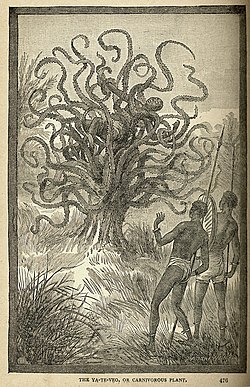Man-eating tree
From Wikipedia, the free encyclopedia
Man-eating tree can refer to any of various legendary carnivorous plants that are large enough to kill and consume a person or other large animal. No such plant is known to exist, though a variety of unconfirmed reports have been recorded.[1] In actuality, the carnivorous plant with the largest known traps is probably Nepenthes rajah, which produces pitchers up to 35 cm (14 inches) in height and will sometimes consume small mammals.[2]
Contents |
[edit] The Madagascar tree
The earliest well known report of a man-eating tree originated as a hoax. In 1881 German explorer "Carl Liche" wrote an account in the South Australian Register of encountering a sacrifice performed by the "Mkodo" tribe of Madagascar:[3]
"The slender delicate palpi, with the fury of starved serpents, quivered a moment over her head, then as if instinct with demoniac intelligence fastened upon her in sudden coils round and round her neck and arms; then while her awful screams and yet more awful laughter rose wildly to be instantly strangled down again into a gurgling moan, the tendrils one after another, like great green serpents, with brutal energy and infernal rapidity, rose, retracted themselves, and wrapped her about in fold after fold, ever tightening with cruel swiftness and savage tenacity of anacondas fastening upon their prey."[4]
The tree was given further publicity by the 1924 book by former Governor of Michigan Chase Osborn, Madagascar, Land of the Man-eating Tree.[5] Osborn claimed that both the tribes and missionaries on Madagascar knew about the hideous tree, and also repeated the above Liche account.
In his 1955 book, Salamanders and other Wonders,[6] science author Willy Ley determined that the Mkodo tribe, Carle Liche, and the Madagascar man-eating tree itself all appeared to be fabrications.
[edit] Ya-te-veo
The Ya-te-veo ("I see you") is a carnivorous plant said to grow in parts of Central and South America with cousins in Africa and on the shores of the Indian Ocean. There are many different descriptions of the plant, but most reports say it has a short, thick trunk and long tendrils of some sort which are used to catch prey. In J.W. Buel's Land and Sea (1887), the plant is said to catch and consume large insects, but also attempts to consume humans. As with most reports of man-eating trees, the Ya-te-veo is most likely an exaggerated story of an actual species of carnivorous plant, similar to those already known to science.
[edit] Duñak
The Duñak is a carnivorous tree described in tribal tales from the Philippines and other areas of South-East Asia.[citation needed] It is said to resemble a monsoonal tree with very thick foliage and dark bark, occasionally said to have a reddish hue. It does not appear abnormal until a large animal walks under its branches, at which point barbed vines extend down from the tree to wrap themselves around the animal. The animal is then lifted up into the foliage, crushed to death, and consumed. It is said to have occasionally taken humans, but mostly does not prey on anything larger than deer and other ungulates native to the region. Some cryptophytologists believe the Duñak to actually be one of the larger members of Drosera, although would most probably not take prey larger than frogs and small mammals. Others believe the fanciful tales merely describe the hunting habits of one of the species of python native to the area.
[edit] In fiction
Man-eating plants have figured in a number of science fiction stories and films. A central character in The Little Shop of Horrors (1960), its stage musical spinoff, and the musical film, is Audrey Jr. ("Audrey II" in the 1986 remake), a talking plant that feeds off human blood and flesh. Yann Martel's novel, Life of Pi, featured a floating island of carnivorous algae that presumably digested a human castaway, leaving only a single molar wrapped in its leaves. A more serious example was the January 12, 1957 episode of Science Fiction Theatre, "The Killer Tree".[7] Stanley G. Weinbaum's 1935 short story, Parasite Planet, describes a variety of carnivorous plants on Venus that eat humans and each other.
[edit] See also
[edit] References
- ^ Shuker, Karl (2003). The Beasts That Hide From Man. Paraview. ISBN 1-931044-64-3.
- ^ Phillipps, A. 1988. A Second Record of Rats as Prey in Nepenthes rajah. Carnivorous Plant Newsletter 17(2): 55.
- ^ Ron Sullivan and Joe Eaton (October 27, 2007). "The Dirt: Myths about man-eating plants - something to chew on". San Francisco Chronicle. http://www.sfgate.com/cgi-bin/article.cgi?f=/c/a/2007/10/27/HOIASVF6T.DTL. Retrieved on 2007-10-26.
- ^ Tyson, Peter. "A Forest Full of Frights, part 2". The Wilds of Madagascar. Nova Online. http://www.pbs.org/wgbh/nova/madagascar/surviving/frights2.html.
- ^ Osborn, Chase Salmon (1925). Madagascar, Land of the Man-eating Tree.
- ^ Ley, Willy (1955). Salamanders and other Wonders. Viking Press.
- ^ "Science Fiction Theatre; "Killer Tree" Episode Summary". TV.com. http://www.tv.com/science-fiction-theatre/killer-tree/episode/126835/summary.html.
[edit] Other sources
- Michell, John and Rickard, Bob (2000). The Rough Guide to Unexplained Phenomena. Rough Guides. ISBN 1-85828-589-5.


